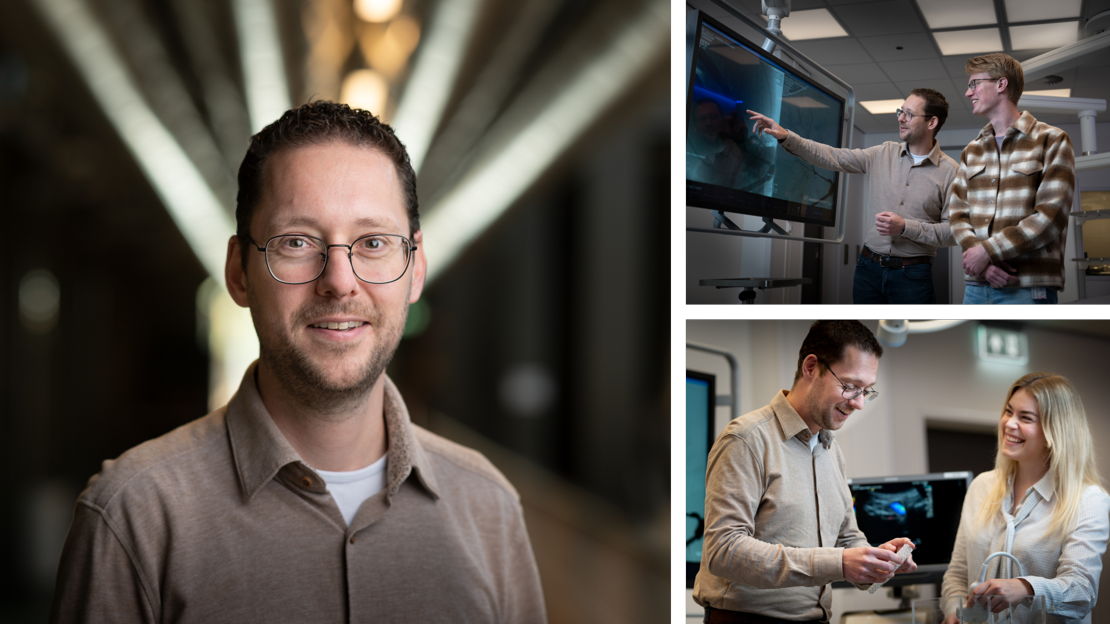Understanding blood flow to provide better care
Erik Groot Jebbink studies how blood flow impacts vascular diseases and their treatment. To this end, he has developed new methods to obtain blood flow measurements in the lab as well as inside the body. “Having this knowledge will help us track the progress of the disease and design optimal treatments for patients.”
“My research is all about blood flow in the human circulatory system,” says Erik Groot Jebbink, Assistant Professor at the Multi-Modality Medical Imaging (M3i) group. The focus of his work is developing methods for quantifying how the blood flows. A challenging topic, as it is very difficult to observe the blood stream directly inside a human body. “Flow velocities easily reach 1m/s and vary dramatically during the cardiac cycle. And, naturally, we cannot install a photo camera inside the blood stream to observe it,” explains Groot Jebbink.
The UT scientist has therefore worked on new techniques to obtain blood flow measurements in vivo - inside the body - to be able to accurately study the interaction between blood flow, the vessel wall and medical treatments applied to patients with vascular diseases. As the base method, he applies a special type of high frame ultrasound that can capture up to 10.000 frames per second. “It’s essentially like making a slow-motion video of blood flow,” says Groot Jebbink. “We also inject microbubbles into the patient’s blood stream to get extra contrast in the images and be able to trace the flow better. This helps us investigate the flow and dynamics in the entire vessel and over time.”
The researcher is already busy with clinical trials, testing the newly developed methods on patients in the department of vascular surgery of the Rijnstate Hospital Arnhem, where he works part-time. “These patients already undergo ultrasound scans, and so it is relatively easy to implement our new technique,” says Groot Jebbink. “Using ultrasound is very cost-effective because it is already used in clinical routine. It’s a much cheaper and easier method than MRI which is costly and generally overbooked.”
As he says himself, Erik Groot Jebbink’s research is closely linked to practice. His background in technical medicine and part-time position in the hospital help him bring new techniques developed at the UT to the clinic. “In the clinic we can use the techniques, identify problems, and bring the techniques back to the university to address these problems before we bring them back to the clinic. This is a really valuable feedback loop that speeds up the development of new technologies.”
And bringing these new methods to the clinic could have a huge impact on people’s lives. It could specially make a difference for patients with atherosclerosis, a leading cause of vascular disease worldwide. The condition refers to the buildup of fats, cholesterol and other substances in and on the artery walls and affects many people in the Western world due to bad diet and lifestyle. “Blood flow has a big impact on this disease, but we don’t have a full understanding of it yet,” says Groot Jebbink. “We want to understand how atherosclerosis and vascular diseases develop and what impact medical treatments have on blood flow. There is so much to learn about how blood flows through the human body, and its impacts on diseases and treatments.”
Ultimately, Erik Groot Jebbink hopes that the measurements he’s developing will become a standard part of treatment. “In my work, I combine in vitro models, computer simulations and in vivo techniques – this combination makes it the ultimate platform. I hope this will help us get a good overview of blood flow before, during and after treatment. In the end, it is all about providing better care for patients.”
Education
Erik Groot Jebbink teaches various courses in the Technical Medicine programme, including courses on Imaging Techniques and Surgical Skills. “We aim to ensure that students not only gain the practical skills to perform surgeries, but also the clinical reasoning before their actions,” says the scientist. “Having this reasoning is equally important because you need to be able to determine when and why to operate on a patient, what to do in case of complications and how you even determine that there are complications.” Most importantly, Groot Jebbink wants the students to understand that everything they are taught at the UT has a practical purpose in the clinic. “We want them to understand how to apply everything they learn at the university in actual care. What we teach them is not just a random piece of information. It is useful and important for patient care.”
About Erik Groot Jebbink
Erik Groot Jebbink is a Tenure Track Assistant Professor at the Multi-Modality Medical Imaging (M3i) group, Faculty of Science and Technology (TNW) of the University of Twente. He studied Technical Medicine at the University of Twente, where he also obtained his PhD (2017) on the topic of the interaction between stents and blood flow in case of stenotic vascular pathologies. His PhD was set up as a six-year project with a 50/50 balance between research and education, as he was involved in several courses within the Technical Medicine programme. During his Postdoc research, he expanded his PhD work into a new research line within the M3i group, where he was appointed an Assistant Professor in 2019. Groot Jebbink also holds a part-time position at the department of vascular surgery at the Rijnstate hospital in Arnhem. Erik Groot Jebbink was awarded the prestigious VENI grant in 2020 and in 2023 he was selected as a member of the Dutch CardioVascular Alliance (DCVA) leadership programme.
Press Photos
These press photos can be used, please include the name of the photographer, Fokke Eenhoorn.

